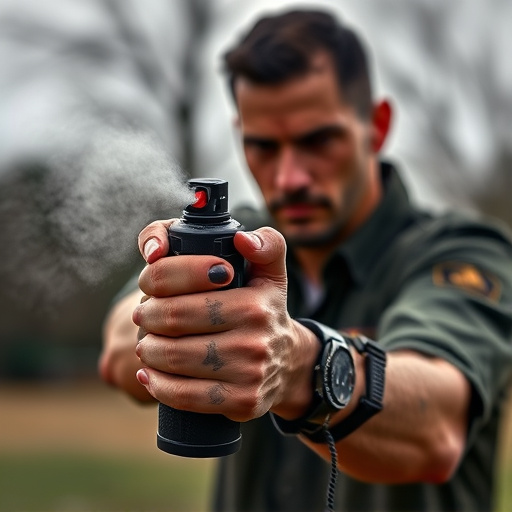Tactical pepper spray, a powerful self-defense tool, uses capsaicin to create temporary blindness and breathing difficulties in assailants. With various deployment methods like canisters, hand-held devices, and aerial systems, users can quickly defend against multiple attackers or confined space intruders. Understanding aiming techniques (e.g., targeting eyes and face), proper breathing, and combining spray with strikes significantly improves combat readiness. Carrying pepper spray comes with responsibilities: secure storage, legal knowledge, responsible deployment, and minimizing bystander impact. Training in tactical methods enhances effectiveness while prioritizing awareness, control, and security.
“Unleashing the power of tactical pepper spray can be a game-changer in self-defense scenarios. This potent weapon, designed for maximum strength, offers more than just a temporary solution; it’s a strategic tool for personal safety. Our article delves into the intricacies of tactical pepper spray deployment methods, providing insights on its immense potential and effective use. We explore various techniques, from understanding the spray’s power to practical deployment strategies, while also highlighting crucial safety and legal considerations for responsible ownership.”
- Understanding Tactical Pepper Spray: Its Power and Purpose
- Deployment Techniques: Effective Strategies for Maximum Defense
- Safety and Legal Considerations: Responsible Use and Storage
Understanding Tactical Pepper Spray: Its Power and Purpose
Tactical pepper spray is a powerful self-defense tool designed for law enforcement and military personnel, offering a non-lethal but highly effective means to incapacitate an attacker. Its primary purpose is to create a temporary yet severe sensory overload, enabling the user to gain time and escape from dangerous situations. The power of tactical pepper spray lies in its active ingredient—capsaicin, the same compound responsible for the heat sensation in chili peppers. When deployed, it irritates the eyes, nose, throat, and skin, leading to pain, temporary blindness, and difficulty breathing.
Deployment methods vary to suit different scenarios. These include canisters that emit a concentrated spray, hand-held devices for close-range use, and even aerial dispersion systems for large-scale operations. Each method ensures the swift release of pepper spray particles, allowing users to defend against multiple assailants or contain disturbances in confined spaces. Understanding these tactical deployment techniques is crucial for individuals seeking to enhance their personal safety during high-risk activities or in areas with elevated security threats.
Deployment Techniques: Effective Strategies for Maximum Defense
When it comes to tactical pepper spray deployment methods, understanding the right techniques can significantly enhance self-defense capabilities. One effective strategy involves aiming for the eyes and face. The sensitive nature of these areas ensures that a direct hit will cause temporary blindness and disorientation, providing an opportunity to escape or disable the attacker. It’s crucial to practice proper breathing and aim for the center of the target to maximize impact.
Additionally, using tactical pepper spray in conjunction with other self-defense tactics can prove indispensable. For instance, combining spray deployment with strikes or blocks can confuse an assailant, making it harder for them to anticipate your moves. Practicing these techniques together enhances overall combat readiness and ensures that you’re prepared for various scenarios involving armed aggressors.
Safety and Legal Considerations: Responsible Use and Storage
When carrying tactical pepper spray, understanding safety and legal considerations is paramount. Always ensure the spray is stored properly, out of reach of children and unauthorized individuals. It’s crucial to familiarize yourself with local laws regarding pepper spray ownership and use, as regulations vary widely. Responsible use involves aiming accurately, using only when necessary, and respecting the impact on bystanders.
Safe deployment methods include holding the canister at close range (around 3-4 inches) and targeting the eyes, nose, and mouth. Training in tactical pepper spray deployment methods can be invaluable, teaching you how to maximize its effectiveness while minimizing collateral damage. Remember, pepper spray is a powerful tool designed for self-defense; responsible use requires awareness, control, and respect for both personal safety and that of others.
Tactical pepper spray, when used responsibly, can be a potent self-defense tool. By understanding its power and learning effective deployment methods, individuals can enhance their personal safety. The article has explored tactical pepper spray’s purpose, from disorienting assailants to providing crucial time for escape. It has also highlighted the importance of safety and legal considerations, emphasizing responsible use and proper storage. Mastering different deployment techniques empowers folks to protect themselves in various scenarios, making it a valuable asset for personal security.
